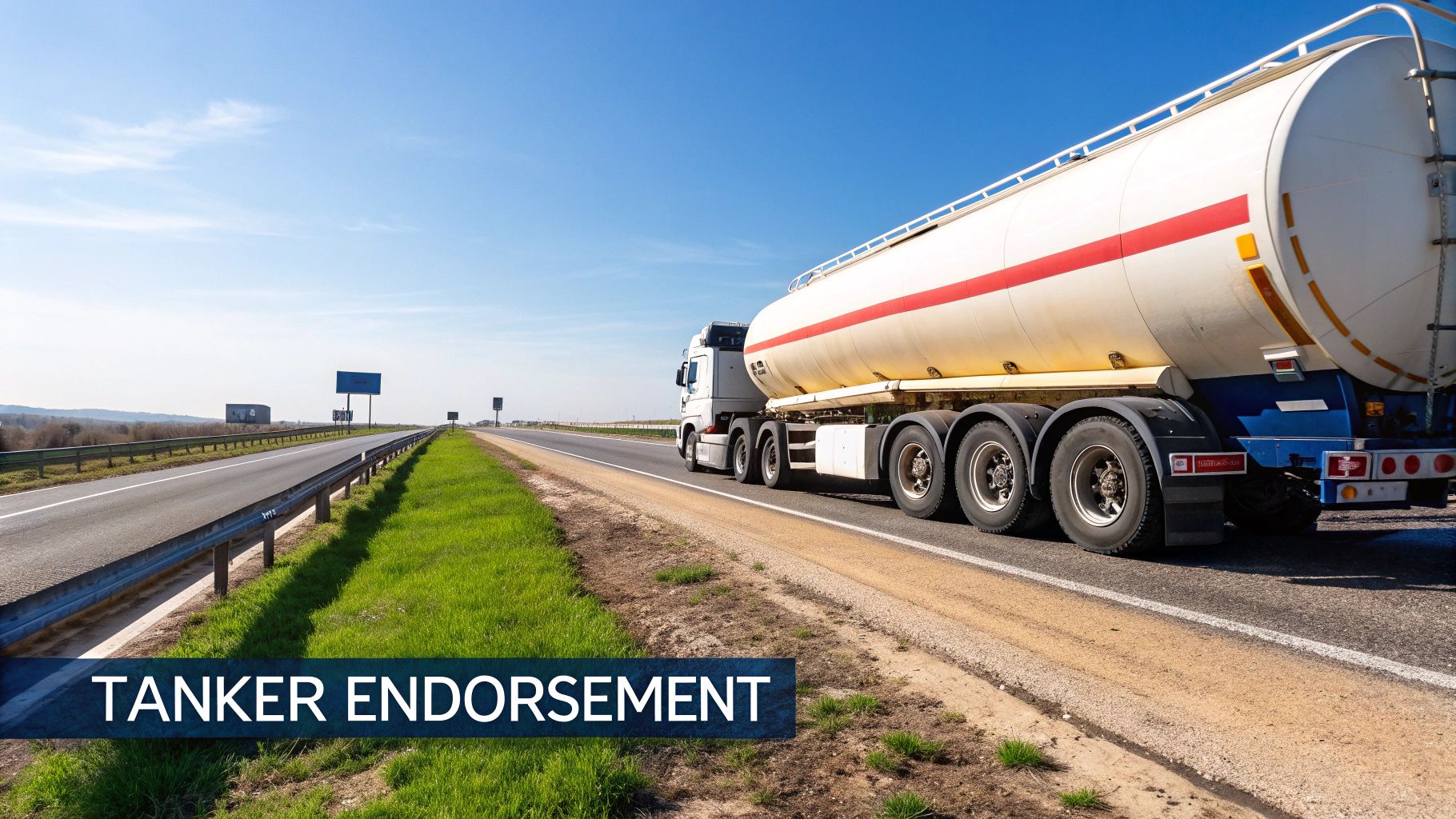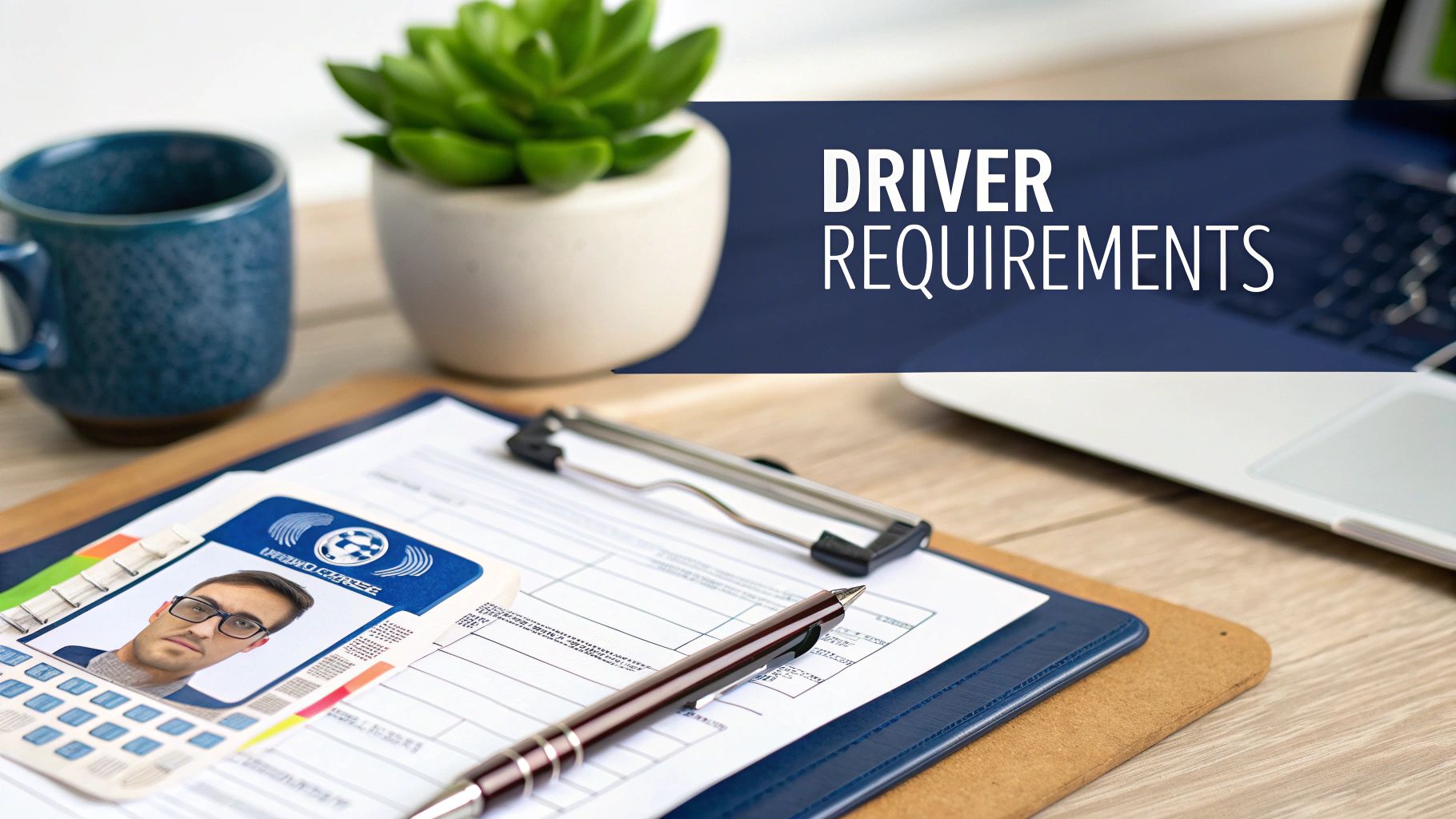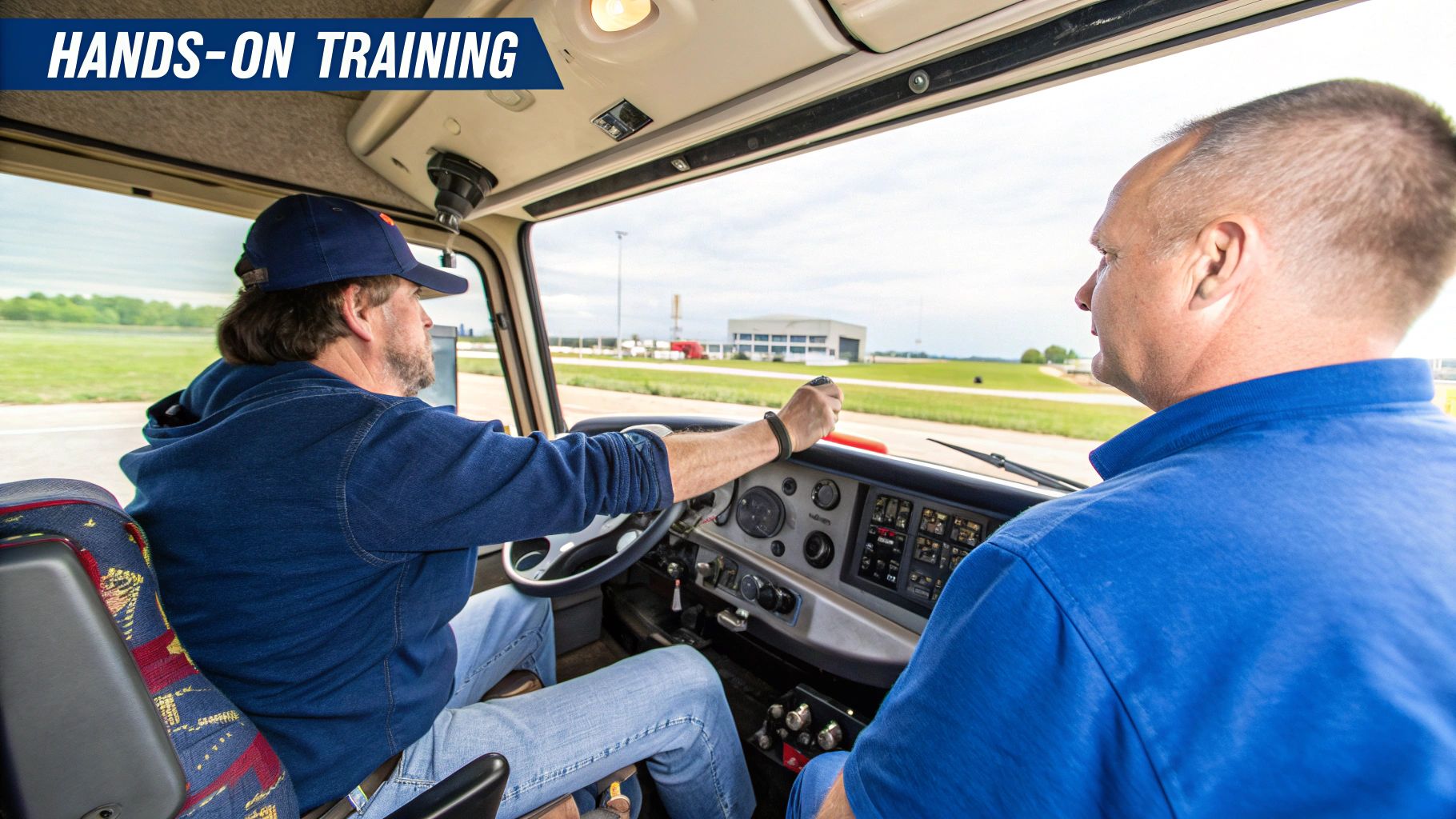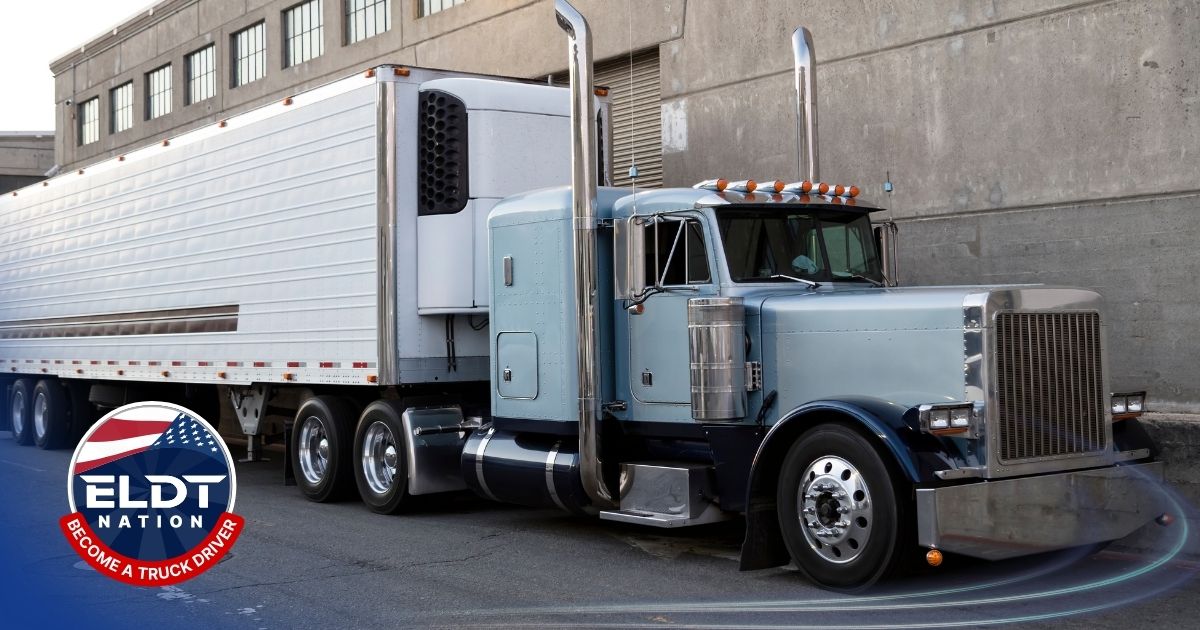What Is A Tanker Endorsement? - Complete Guide
What Is A Tanker Endorsement And Why Truckers Need It

If you've ever noticed a CDL with the letter “N” on it, you’ve seen a tanker endorsement. Think of it as a special certification that allows a driver to haul bulk liquid cargo. It's much more than a simple stamp on a license; it’s proof that you have the specific skills to handle a uniquely challenging type of freight. Hauling thousands of gallons of liquid is a completely different world from hauling pallets of neatly boxed goods.
Imagine your trailer is carrying 8,000 gallons of milk. When you brake or take a sharp turn, that liquid doesn't just stay put. It sloshes forward, backward, and side-to-side with incredible force. This powerful movement is known as liquid surge, and it can dramatically affect your truck's balance and momentum. A sudden surge could push your rig into an intersection or, even worse, cause a rollover if you aren't prepared for it. This inherent risk is exactly why a special endorsement is required.
Understanding The Official Requirement
So, what is a tanker endorsement in official terms? It's a certification required for any driver operating a vehicle designed to transport large volumes of liquids or gases. The key here isn't what you're hauling, but the capacity of the tank itself. An "N" endorsement is required for vehicles with tanks that have either:
- An individual rated capacity of more than 119 gallons, or
- A combined tank capacity of 1,000 gallons or more
This rule applies whether you're transporting milk, fuel, water, or industrial chemicals. You can find more details on these rules by exploring information on tanker regulations.
The danger comes from the physics of the shifting liquid inside, not just the type of liquid. Earning the N endorsement proves you understand how to manage these powerful forces, handle loading and unloading procedures safely, and respond correctly during an emergency. It's a critical qualification that keeps you and everyone else on the road much safer.
When You Actually Need Tanker Endorsement

So, when does the law actually require you to have a tanker endorsement on your CDL? It all boils down to the size of the tanks you're hauling, and the rules are very specific. You can’t just eyeball it—the Department of Transportation (DOT) won’t accept "I thought it was smaller" as an excuse during an inspection.
The rules, clearly defined by the Federal Motor Carrier Safety Administration (FMCSA) back in 2011, center on two main capacity thresholds. A driver needs the N endorsement if their commercial vehicle is hauling liquids or gasses in a tank with either an individual rated capacity of more than 119 gallons or an aggregate rated capacity of 1,000 gallons or more. You can find more details about how these tanker rules were established on ATSinc.com.
Understanding The Capacity Rules
This obviously covers the massive rigs you picture when you think of tanker trucks, like fuel haulers and milk tankers. But it also catches some drivers by surprise. Imagine you're driving a flatbed with four separate 250-gallon intermediate bulk containers (IBCs). Even though no single tank is massive, their combined capacity is 1,000 gallons, which means you legally need the endorsement.
Another common point of confusion is what’s in the tank. Some drivers mistakenly believe they only need the endorsement for hazardous materials. However, the law is concerned with the physics of liquid movement, not its chemical properties. Whether you're hauling milk, water, or industrial chemicals, the size requirements apply equally.
To help clear things up, the table below breaks down different scenarios to show you exactly when that "N" on your CDL is a must-have.
Official FMCSA Requirements - Tank Size Requirements For Endorsement
In short, you must have a tanker endorsement if you are hauling any liquid or gaseous material in a tank larger than 119 gallons or in multiple tanks that add up to 1,000 gallons or more. Don't get caught without it.
Why Hauling Liquids Changes Everything
Driving a truck loaded with liquid is a completely different world from hauling solid cargo. Imagine having 8,000 gallons of fuel sloshing around in your trailer. Every time you touch the brakes, accelerate, or take a turn, that entire mass of liquid moves. This powerful effect is known as liquid surge, and it's a force that can surprise even experienced drivers if they aren't prepared. It is the single biggest reason a tanker endorsement is a must-have.
When you brake, thousands of gallons of liquid slam toward the front of the tank, pushing your truck forward with incredible force. It can feel like your own trailer just rear-ended you. On the flip side, when you accelerate, the liquid surges to the back, which can make your tractor feel surprisingly light and less connected to the road.
The most dangerous movement, however, is the side-to-side slosh. If you take a curve too quickly, the liquid will shift sideways, dramatically raising your rig's center of gravity and creating a serious risk of a rollover.
The Dynamics of Different Liquids
Not all liquids are created equal, and knowing how they behave is essential for safe driving.
- Thin liquids, such as gasoline or water, move very quickly. This creates a fast, powerful surge that hits the tank walls hard.
- Thick liquids, like molasses or certain chemicals, are much slower. Their surge feels less like a sudden jolt and more like a slow, heavy push.
To manage this movement, some tanks are equipped with internal walls called baffles. These barriers help break up the waves and keep the liquid from sloshing uncontrollably. Other tanks, particularly those in the food-grade industry, are smoothbore and have no baffles at all. Driving a smoothbore tank demands an even higher level of skill, as there's nothing to dampen the surge. This isn't just theory—understanding how liquids move is what separates a safe, professional tanker driver from an accident waiting to happen.
How To Get Your Tanker Endorsement Step By Step

Getting your tanker endorsement is much more straightforward than you might think. Unlike the extensive road training needed for your initial CDL, the "N" endorsement is all about proving what you know. This means your entire focus will be on passing a written knowledge test.
The best part? There is no road test required for the tanker endorsement itself. This makes the whole process faster and a lot less stressful. Success comes down to preparing well for the written exam.
Your Action Plan for Getting the Endorsement
Your first move is to study. Grab a copy of your state’s CDL manual from the local DMV or look up practice tests online—many are available for free. These resources will get you comfortable with the questions you'll see on the actual test.
When you study, zero in on these critical topics:
- Liquid surge: Understand how the "slosh" of liquid affects your truck's handling, especially during braking and turns.
- High center of gravity: Learn the unique stability challenges that come with hauling thousands of gallons of liquid.
- Tank design: Know the difference between baffled, smoothbore, and other tank types.
- Safety protocols: Master essential pre-trip inspection points and emergency procedures specific to tankers.
Once you feel ready, it’s time for a trip to the DMV. You'll need to bring your current CDL, fill out the application, and pay a small fee. The cost varies by state but is typically very affordable, often between $10 and $30.
To help you map out the process, here's a complete checklist of the steps involved.
Tanker Endorsement Process Steps
Complete checklist of requirements and steps to obtain your tanker endorsement
StepRequirementTimelineCost Range1. StudyReview the tanker section of your state's CDL manual. Use online practice tests.2-10 hours, depending on study habits$0-$20 for study materials2. Visit the DMVBring your current, valid CDL and any other required ID.30-60 minutesN/A3. ApplyFill out the state-specific application form for an endorsement.10-15 minutesN/A4. Pay FeePay the application and testing fee at the DMV.5 minutes$10-$30 (varies by state)5. Take TestPass the written knowledge test, usually consisting of 20 questions.15-30 minutesN/A6. Receive EndorsementOnce you pass, the DMV will officially add the "N" endorsement to your license.10-20 minutesN/A
As you can see, the timeline is very manageable. The test itself is typically short, usually around 20 multiple-choice questions, and you’ll need to answer a high percentage correctly to pass. If you've just started your trucking career, our guide on how to get a CDL can provide a full overview of the initial licensing process. With good preparation, you can earn your tanker endorsement in just a few hours.
What You'll Study For The Tanker Test
The tanker endorsement test isn't about memorizing obscure facts. It’s designed to make sure you truly understand the risks that come with hauling thousands of gallons of shifting liquid. The biggest concept you'll need to master is liquid surge—the powerful sloshing motion of your cargo and how it can dramatically affect your truck's handling.
Imagine trying to walk a straight line while carrying a large tub of water. Every time you stop, start, or turn, the water sloshes and pushes you around. Now, scale that up to 8,000 gallons of milk or fuel. That's why the test focuses so heavily on this principle. You’ll learn why a partially filled tank is often more dangerous than a full one and why smooth, steady driving is non-negotiable.
Key Knowledge Areas
The written test will cover several critical areas to confirm you're ready for the unique challenges of tanker driving. Expect to see questions on these topics:
- Tank Designs: You need to know the difference between tank types. Some tanks have internal walls called baffles, which help reduce the force of liquid surge. Others are smoothbore (completely open inside), which require even greater skill and awareness to handle safely.
- Loading and Weight Distribution: Getting the weight right is essential. You'll study proper loading procedures and why certain liquids can never be mixed. This knowledge is especially important if you plan to get your HAZMAT certification. If that's a goal, you can learn more about the Hazmat Endorsement.
- Emergency Response: Knowing what to do when things go wrong is critical. The test covers how to handle spills, react to equipment failures, and when to call for emergency services.
- Vehicle Inspections: A tanker pre-trip inspection is far more detailed than a standard one. You’ll learn how to check the tank itself for leaks or damage, make sure all valves and pipes are secure, and confirm all safety equipment is ready to go.
Mastering these topics shows you have the practical knowledge needed to operate a tanker truck safely and professionally.
Better Jobs And More Money With Tanker Work
Let's get straight to the point: earning your tanker endorsement is a direct path to a bigger paycheck. Jobs involving tankers nearly always pay more than typical dry van or reefer positions. The reason is simple supply and demand—fewer drivers have the N endorsement and the specialized knowledge required to transport liquids safely. This immediately makes you a more valuable hire.
Even local tanker jobs, like hauling milk, can provide a great living. These routes often pay between $60,000-$70,000 per year, and many come with solid benefits and the huge plus of being home regularly. If you’re open to handling more complex cargo, the pay increases even more.
Higher Pay For Higher Skill
Not all tanker jobs are the same, and the pay reflects the level of skill and risk involved.
- Fuel Transport: Hauling gasoline or diesel is a step up in pay, particularly if you’re willing to work nights or weekends when demand is high.
- Chemical Hauling: This is often the highest-paying segment of tanker work. It requires a HAZMAT endorsement on top of your tanker one, plus more intensive training.
These jobs don't just offer better pay; they offer stability. Communities always need milk, gas stations constantly need fuel, and industrial plants require a steady supply of chemicals. This translates to consistent, year-round work. You can see how these specialized roles compare financially in our article on how much truck drivers make.
Of course, the extra money comes with added responsibility. Tanker work can be more demanding. You're in charge of liquids that can be hazardous, you must follow strict safety protocols, and the equipment needs your full attention. Some drivers enjoy this challenge, while others prefer the more straightforward nature of dry freight. The important thing is that understanding what is a tanker endorsement and earning one gives you the freedom to choose your path.
Ready to get the endorsements that lead to better jobs? ELDT Nation offers FMCSA-approved online theory courses for your CDL, Hazmat, and Passenger endorsements. Start your training today by visiting ELDT Nation.



%20Endorsement%20-%20Online%20ELDT%20Training%20NJ.jpg)



